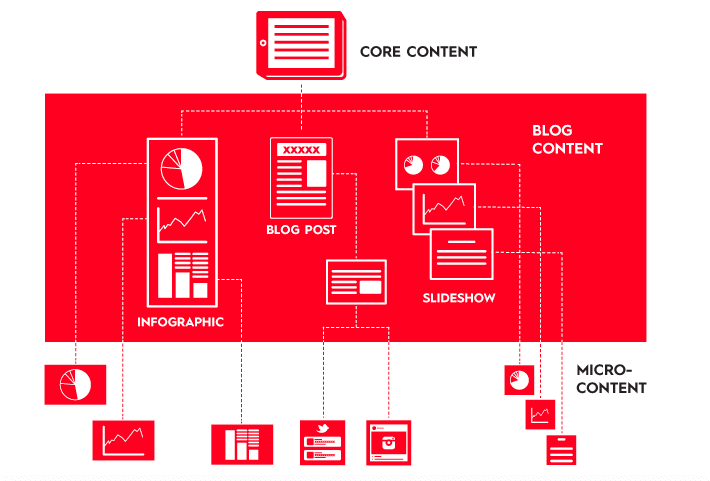According to Gartner’s Annual CMO Spend Survey, average marketing budgets have fallen 15%. Now, marketers have to do more with less—with more pressure than ever. Worse, marketing is a never-ending carousel of tasks, from content creation and strategy to distribution and reporting. How do you handle them all when you have a small marketing budget? Luckily, we’re here to help you maximize your budget and make the most of the resources you have.
7 Strategies to Work with a Small Marketing Budget
We’ve been in the game for over a decade, and in that time we’ve helped our clients clean up their messy marketing, optimize their infrastructure, and create repeatable processes to improve efficiency, so we know how to hack our way into working smarter, not harder—and getting better results. If you’re looking for ways to improve your market (even with a small budget), here are seven successful strategies you should try ASAP.

1) Put AI to use.
One of the best things about AI is its ability to automate or absorb tedious tasks that eat up time. When you’re struggling to solve big-picture problems, you don’t need to waste precious brainpower on this type of labor. Instead, consider ways you can implement AI at every level of your marketing organization to save time and build a better brand experience for your customers. Whether it’s A/B testing subject lines, synthesizing data, brainstorming ideas, or outlining content, there are so many ways AI can boost your marketing.
Tip: AI marketing is overwhelming for a lot of people, but you just need to know how to apply it. Find out more about the 30 ways AI can help your marketing, use these 75 prompts to build an AI-driven strategy, and see our ultimate guide to AI to learn more about its applications.
2) Choose the right tools.
AI tools are the hot new kid on the town, but there are many additional tools that can help you streamline your work, outsource labor, and create content (especially when you have a small marketing budget).
We’ve experimented with a variety of tools for a variety of tasks over the years, which has empowered our team to work quicker and more efficiently.
Check out our tool roundups for:
- Blogging
- Branding
- Content Creation
- Content Strategy
- Content Marketing
- Copywriting
- Ebooks
- Employer Branding
- Infographics
- AI Marketing
Tip: To avoid making your whole team go through the learning curve when working with a new tool, it can help to assign a small team to become proficient and build out a handy user guide. This makes it easier for everyone else to adopt it.
3) Use a divisible content strategy.
Any content takes time, energy, and resources to produce, so you want to maximize every new piece of content you create. A divisible content strategy is one of our favorite ways to do this.
With this approach, you create a hero piece of core content intended to be broken into smaller content pieces and formats, such as blog posts, social media content, infographics, or quotes. These smaller pieces can delve into different aspects of the core content, present the info in a different package, or start different conversations with different audiences.

Most importantly, this approach helps you expand your reach, maximize resources, and create a larger volume of content with less investment.
Tip: To do this effectively, you need to carefully plan out each piece of content before you create it. This means you start with a more detailed outline for the core content, then identify what content you will flesh out into supporting pieces. For a more detailed guide on how to map this content, find out more about how a divisible content strategy works.
(BTW, you will also want to periodically refresh and update your core content to make sure it’s relevant.)
4) Repurpose and recycle existing content.
While a divisible content strategy hinges on the creation of new content, you probably have a ton of existing content that can be reimagined, recycled, repackaged, or repurposed for use. (Again, anytime you’re investing in content, you want to make the most of it.)
Comb through your archive to find pieces you can update or, even better, translate into different formats to expand reach across channels. For example, you might…
- Convert a blog post into a video or podcast episode.
- Turn a series of tips into a video series.
- Turn your ebooks into eye-catching infographics.
- Turn presentations into interactive slideshows.
- Turn old blogs into a fresh ebook.
Tip: Data storytelling is always a good way to gain credibility and enhance any piece of content you create. Find out more about how to repurpose data visualizations throughout your content.
5) Turn your team into content creators.
There is so much untapped talent in your company—outside of your marketing team. Not only should this talent be used but it should be celebrated and spotlighted. If you are struggling to create content (thanks to a small marketing budget), get support from people outside the department.
- Who are the experts developing your product/service?
- Who has a unique perspective on the industry?
- Who extracts interesting insights from your data?
- What interesting conversations have salespeople been having?
There are plenty of opportunities to translate their thoughts into interesting, relevant, and even newsworthy content.
Tip: You can certainly recruit people to write articles for you, but there are also low-effort ways to turn their thoughts into high-quality content.
- Do an expert Q&A via email.
- Record a podcast conversation with a thought leader.
- Ask your team for their best tips on a specific subject and publish them as a roundup.
For more tips, see our guide to turn your coworkers into content creators.
Additionally, although thought leadership is great, you can also use other employees to showcase your brand’s culture. (This is a great way to humanize your brand to potential customers and potential employees.) See our guide to culture marketing, and try these ideas to showcase your culture on social media.
6) Experiment with agile marketing.
There’s nothing more frustrating than wasting money on campaigns that flop. (We know this firsthand.) That’s why we’ve been experimenting with an agile marketing approach that relies on simple test-and-learn experiments to gather market insights.
By deploying these simple, constructed experiments, you can better adjust your spending, optimize your content, and improve your campaigns—with better results.
Tip: Allocate a portion of any paid media spend to agile campaign testing. For more detail on how to implement this strategy, see our guide to agile marketing.
7) Leverage User-Generated Content (UGC)
In addition to your own internal resources, your own audience can be a great way to generate low-lift content that increases engagement. This can take many forms:
- Polls
- Quizzes
- Contests
- Tips
- Customer Success Stories
- Social Takeovers
You can also piggyback off of content you’ve already created by encouraging your audience to create their own version, add their perspective, etc.
Not only does this reduce the amount of content you have to personally create but it gives you a chance to build stronger connections with your community. (For more ideas, find out how to incorporate UGC into your content strategy.)
How to Improve Efficiency Overall
We hope you can incorporate these tips into your existing marketing practice, but remember that maximizing your budget is, ultimately, about maximizing your investments of everything: time, money, and energy. A few more things that might help:
- Optimize your production process. See our guide to improve your end-to-end process and produce content as efficiently as possible.
- Improve your brainstorms. Prompts are a great way to get your creative wheels turning. Use our content brainstorm template to come up with 30 ideas in under an hour.
- Create more sales enablement content. If you can bridge marketing and sales to collaborate on sales enablement content, you can help close more deals. Find out what type of sales content you can invest in (beyond presentations) that can transform your sales process.
That said, if you’re doing the most but still getting subpar results, you may have a larger content strategy issue. If you need any expert guidance, consider bringing in the right partner. If you need a good agency, see our tips to find the right content marketing agency or find out what it’s like to work with us.
Either way, one of the best ways to work smarter is to experiment more. Whether it’s trying a new tool or testing a new strategy, be flexible. Use what works and forget the rest. And if you stumble across any life-changing marketing hacks of your own, our inbox is always open.





